Promachoteuthis sp. B: Description Continued
Richard E. Young and Michael Vecchione
- Tentacles
- Club without keel, carpal locking-apparatus or terminal pad.
- Tentacle club of 10.5 mm ML squid shows a pronounced constriction of the club-bearing portion of the tentacle.

Click on an image to view larger version & data in a new window

Figure. Oral view of a tentacle from Promachoteuthis sp. B taken in the SE Pacific; 10.5 mm ML. Drawing from Roper and Young (1968).
- Suckers
- Arm suckers with ca. 20 rounded to truncate teeth around entire margin (Fig. A).
- Club suckers with ca. 12 small teeth around entire margin (Fig. B).

Click on an image to view larger version & data in a new window
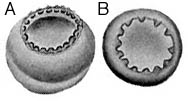
Figure. Oral view of arm (A) and club suckers (B) of Promachoteuthis sp. B taken in the SE Pacific, 17 mm ML. Drawing from Roper and Young (1968).
- Head and funnel
- Buccal connectives attach to the ventral margins of arms IV.
- Funnel component oval with deep, simple bowl-shaped depression.
- Mantle component a rounded knob.

Click on an image to view larger version & data in a new window
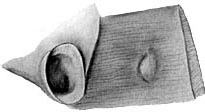
Figure. Funnel locking-apparatus from Promachoteuthis. sp. B taken in the SE Pacific, 17 mm ML. Drawing from Roper and Young (1968)

Click on an image to view larger version & data in a new window
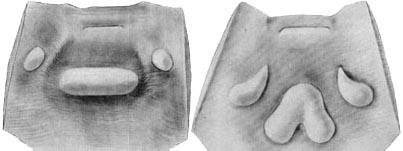
Figure. Funnel organs from Promachoteuthis sp. B taken in the SE Pacific. The funnel organs of two squid differ considerably. The funnel organ of the 10.5 mm ML squid (left) has an oblong dorsal pad and two oval ventral pads. The funnel organ of the 17 mm ML squid (right) has an inverted V-shaped dorsal pad and pear-shaped ventral pads. Drawings from Roper and Young (1968).
- Radula
- Heterodont radula.
- Rhachidian with large median and two lateral cusps.
- Lateral tooth I with large medial cusp and small conical lateral cusp.
- Lateral tooth II broad and low with sharp medial cusp.
- Marginal tooth long, sharp and curved.

Click on an image to view larger version & data in a new window
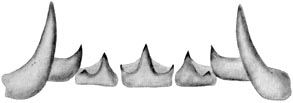
Figure. Radula from Promachoteuthis sp. B taken in the SE Pacific, 17 mm ML. Drawing from Roper and Young (1968).
- Beaks
- Lower beak with broad lateral wall ridge.

Click on an image to view larger version & data in a new window
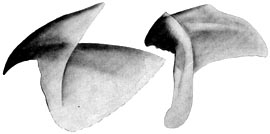
Figure. Beaks from Promachoteuthis sp. B taken in the SE Pacific, 17 mm ML. Left - Upper beak. Right - Lower beak. Drawing from Roper and Young (1968).
- Gladius
- "The gladius is extremely thin and delicate. The free rachis is long, needlelike, delicate and flexible. Anteriorly, it is filamentlike and does not extend to the anterior edge of the mantle. Instead, a filamentous strand of connective tisse extends from its anterior limit to the edge of the mantle. Posteriorly, the rachis extends to the tip of the gladius"Toll (1982), 16.4 mm ML squid, 12.4 mm GL.
This squid has never been described but it has been illustrated in Voss (1992) (drawing below). This specimen is from the type locality and appears to be a valid Promachoteuthis sp. B.

Click on an image to view larger version & data in a new window

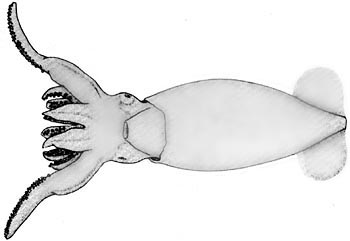
Figure. Promachoteuthis sp. B taken in the S.E. Pacific, 16.4 mm ML. Top - Ventral view of gladius. Drawing from Toll (1982). Bottom - Ventral view of squid. Drawing from Voss (1992).
- North Atlantic specimen (50 mm ML)
- Mantle fused to head.
- Eyes small (3 mm).
- Arms 50% of ML.
- Arm suckers biserial, with smooth rings.
- Tentacle length five times ML; tentacle constriction at club not mentioned.
- Club with maximum of 20 suckers across.
- Tentacle suckers about equal to arm suckers in size.
- Tentacle without band of dark pigment near base.
- Funnel locking-apparatus with round depression (Fig. A).
- Arm suckers with smooth inner rings (Fig. B).

Click on an image to view larger version & data in a new window
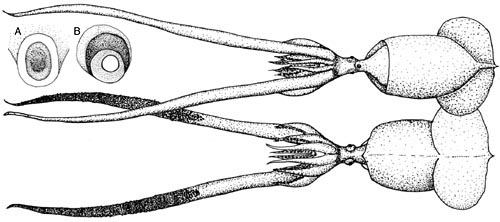
Figure. Ventral and dorsal views of Promachoteuthis sp. B? from the North Atlantic; 50 mm ML. Drawing from Salcedo-Vargas and Guerrero-Kommritz (2000).
- Measurement
| Sex | ? | ? | Immature female |
| Mantle length, mm | 17 | 10.5 | 50 |
| Mantle width | 8 | 6 | 22 |
| Head length | 4 + | 3.3 | 12 |
| Head width | 7 | 4 | 9 |
| Fin length | 7 | 4 | 20 |
| Fin width | 12 | 7.5 | 42 |
| Length, arm I | 3.7 | 3 | 50 |
| Length, arm II | 4 | 3 | 50 |
| Length, arm III | 4 | 3 | 50 |
| Length, arm IV | 4.5 | 4 - | 50 |
| Tentacle length | 13 | 10 | 252 |
| Club length | 9 | 6 | 126 |
| Eye diameter | 0.8 | 0.8 | 6 |
Measurements of the two smaller squids are from Roper and Young (1968) and the largest squid are from salcedo-Vargas and Guerrero-Kommritz (2000).
Comments
The measurements and description by Salcedo-Vargas and Guerrero-Kommritz ( 2000) state that the tentacles of the North Atlantic specimen are 5 times the mantle length; however, the illustration shows the tentacles about 2 1/2 times the mantle length. The large North Atlantic specimen differs from the South Pacific Promachoteuthis sp. B in the apparent lack of constriction of the portion of the tentacle bearing the club and the smooth-ringed suckers. These features along with some differences in proportions may be due to the size differences. Among other features, the relatively small fins, the approximately equal sized arm and club suckers and the same number of club sucker series suggest that this is a Promachoteuthis sp. B.
References
Roper, C. F. E. and R. E. Young (1968). The family Promachoteuthidae (Cephalopoda: Oegopsida). I. A re-evaluation of its systematic position based on new material from Antarctic and adjacent waters. Ant. Res. Ser., 11: 203-214.
Salcedo-Vargas, M. A. and J. Guerrero-Kommritz. 2000. Three new cephalopods from the Atlantic Ocean. Mitt. Hamb. Zool. Mus. Inst., 97: 31-44.
Toll, R.B. 1982. The comparative morphology of the gladius in the Order Teuthoidea (Mollusca: Cephalopoda) in relation to systematics and phylogeny. PhD. Dissertation, University of Miami, 390 p
Voss N. A. 1992. Family Promachoteuthidae. Smithson. Contr. Zool., 513: 183-185.
About This Page

University of Hawaii, Honolulu, HI, USA

National Museum of Natural History, Washington, D. C. , USA
Page copyright © 2003 and Richard E. Young
 Page: Tree of Life
Promachoteuthis sp. B: Description Continued
Authored by
Richard E. Young and Michael Vecchione.
The TEXT of this page is licensed under the
Creative Commons Attribution-NonCommercial License - Version 3.0. Note that images and other media
featured on this page are each governed by their own license, and they may or may not be available
for reuse. Click on an image or a media link to access the media data window, which provides the
relevant licensing information. For the general terms and conditions of ToL material reuse and
redistribution, please see the Tree of Life Copyright
Policies.
Page: Tree of Life
Promachoteuthis sp. B: Description Continued
Authored by
Richard E. Young and Michael Vecchione.
The TEXT of this page is licensed under the
Creative Commons Attribution-NonCommercial License - Version 3.0. Note that images and other media
featured on this page are each governed by their own license, and they may or may not be available
for reuse. Click on an image or a media link to access the media data window, which provides the
relevant licensing information. For the general terms and conditions of ToL material reuse and
redistribution, please see the Tree of Life Copyright
Policies.


This page is a note that is attached to a
leaf of the Tree of Life.
ToL notes provide brief accounts of characteristics, short summaries,
commentaries, media files, taxonomic information, or identification tools
for a given group of organisms.
For a more detailed explanation of the different ToL page types, have a look at the
Structure of the Tree of Life page.
close box
Page Content
articles & notes
collections
people
options
Explore Other Groups
other Promachoteuthis
containing groups














 Go to quick links
Go to quick search
Go to navigation for this section of the ToL site
Go to detailed links for the ToL site
Go to quick links
Go to quick search
Go to navigation for this section of the ToL site
Go to detailed links for the ToL site